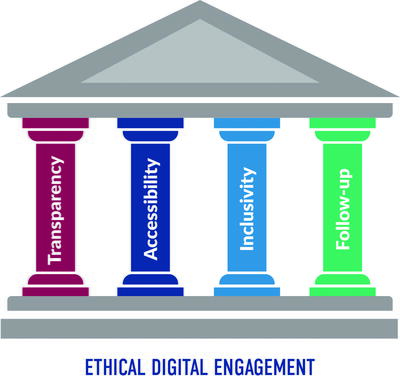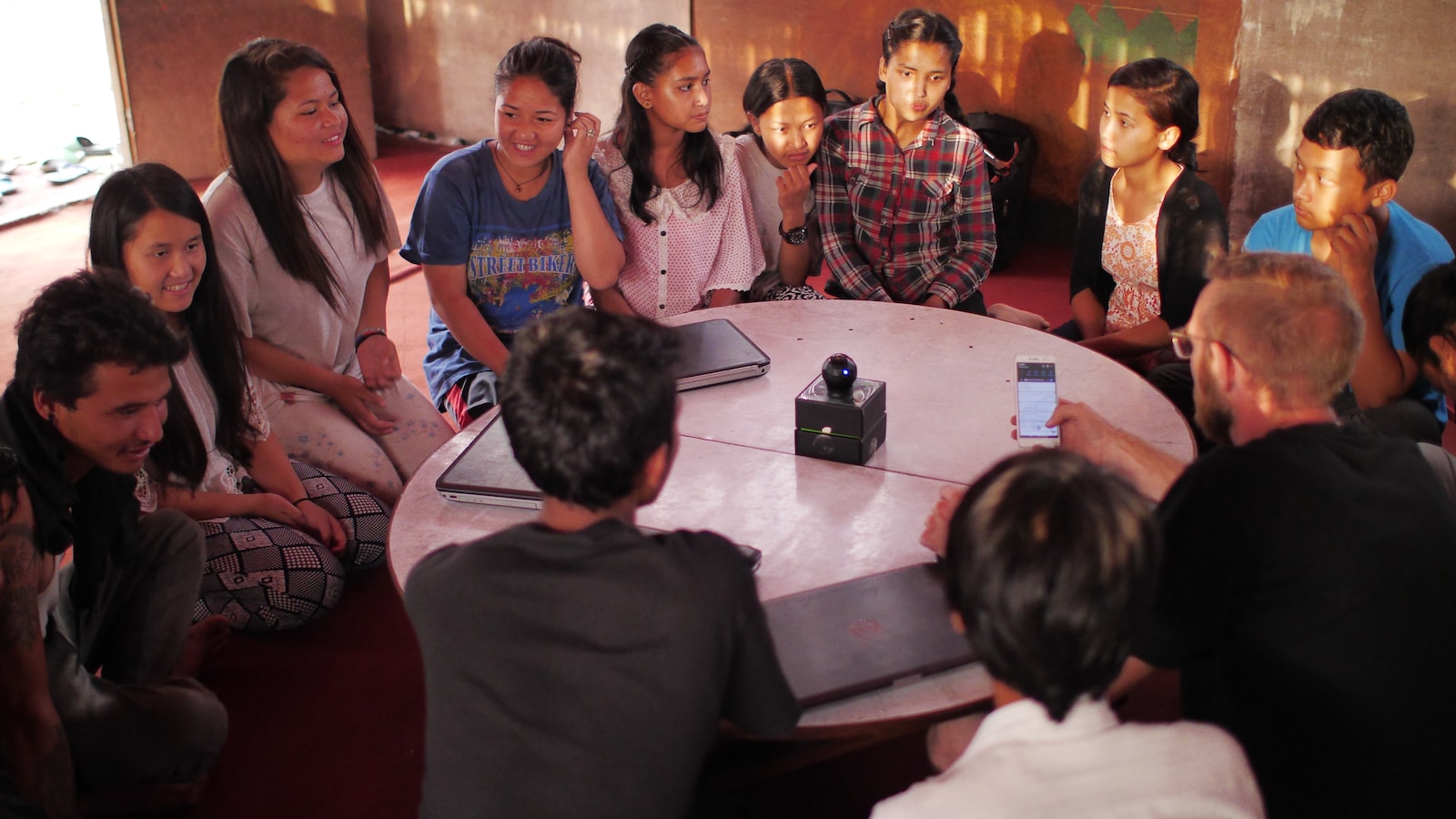
Ethical digital engagement, when designed properly, can create a more inclusive, collaborative, and sustainable public engagement strategy. But it is becoming increasingly difficult to define what exactly ethical digital engagement looks like, and subsequently, what the planning process entails. A large part of that comes from the ubiquitous use of equity, and other connected terms, in the local government space.
These terms are becoming buzzwords in the community engagement process across the globe—and justifiably so. The popularity of these words is certainly a positive advancement given the history of exclusion of marginalized residents in the decision-making process. One of the first steps that local governments can take toward inclusive public engagement is to establish an ethical engagement approach, particularly in the space of ethical digital engagement.
It is no secret that digital adoption has accelerated ever since the COVID-19 pandemic and continues with the current economic climate. The shift to an almost entirely digital space has facilitated a more transparent and accessible engagement process for many cities and counties.
However, going digital can pose concerns to an ethical engagement strategy. More people are creating noise in the “wild wild west of Facebook,” which can lead to the vocal few wielding disproportionate power. Fewer people trust their government with personal data and protecting privacy. Furthermore, there also might be a digital equity imbalance that may lead to bias in the results.
Designing an ethical digital engagement process is community specific and is not easy. While no digital public engagement process looks the same, there are some key principles, described here as the four pillars, that can guide the process.
Understanding the Role of Digital in Ethical Engagement
With seemingly more tools at local government’s disposal, and govtech companies marketing themselves as a “community engagement” solution, it starts to get confusing to define what good, effective digital engagement actually is.
Community engagement “is the process of working collaboratively with and through groups of people affiliated by geographic proximity, special interest, or similar situations to address issues affecting the well-being of those people.”
But what does that look like? How can it be achieved ethically and feasibly within limited resources and staff amidst public engagement burnout?
From community engagement platforms to surveys/maps and social media, local governments can provide more channels to inform and engage residents. As local governments explore these different options, it’s important to distinguish two things: (1) how different tools will be incorporated and (2) in what capacity during the public participation process, which defines the public role from inform to empower. The Davenport Institute uses a modified version of this spectrum, which moves from inform to consult to incorporate to empower in their public engagement training. Both versions rest on the same foundation of public engagement with the goal of building stronger communities through relationships between local governments and their communities.
When preparing to design an ethical digital engagement strategy, I recommend organizing your approach with the following four key principles: transparency, accessibility, inclusivity, and follow-up.

The Four Pillars listed in Figure 1 are the foundation of bringing an ethical approach to digital engagement. When properly built, this foundation will create a more inclusive, collaborative, and sustainable approach to your ethical digital engagement strategy. However, if managed poorly, cracks could begin to form, leading to greater distrust and lower outcomes for cities and counties.
The Four Pillars
1. Transparency
With the rise of engagement platforms and survey companies, social media is still seen as a primary source of online engagement for local governments. Social media provides a great way to broadcast a message in the “inform” stage of the public engagement spectrum, but is it ethical and viable to use social media listening tools as your residents move across the public engagement spectrum?
According to the OECD, only four out of 10 people trust their government. This begs the question, is listening when residents are unaware a collaborative and transparent way to conduct community engagement to increase trust?
Given that trust and credibility are outcomes that must be earned, it is important to consider how to design a digital strategy in a transparent and accountable way. Before creating a digital engagement framework, ask yourself:
- How will data be collected?
- How is data being managed to influence decisions?
- Are you getting consent from the community to collect that data?
It’s fundamental to explore these questions at the beginning stages. It’s best to clearly state why and how you will collect information and how it will be used to make decisions. An ethical digital engagement strategy facilitates prompt updates from organizations and enables residents to easily observe the transparent process, and participate. Remember that actual engagement is inviting all residents to be a part of the conversation where decisions can be made with the community, not for the community.
2. Accessibility
When designing a digital engagement strategy, local governments must consider the end user with regard to accessibility in all forms, including but not limited to: ability, digital literacy, ease of access, and time.
Ensuring everyone has equal access to information, and can participate in the decision-making process, creates a more inclusive and diverse environment. Allowing an open environment for your community to engage allows residents to engage 24/7, giving them the opportunity to engage on their own time. For the residents with disabilities, having a digital strategy that is WCAG 2.1 compliant—a globally recognized standard for making web content accessible—is crucial.
As communities look to adopt technology into the community engagement process, one of the final questions you should consider is: Does the level of digital literacy and digital accessibility in the community match the requirements of this new technology?
The use of traditional methods of engagement (face-to-face, town halls, events, partnerships) is the first step in understanding the levels of literacy and accessibility in the community. Without the proper understanding of the access limitations, racial, ethnic, and socioeconomic minorities will continue to be left out of the conversation. Creating pop-up events to collect feedback on new and existing digital tools is a good way to measure community interest and digital literacy. Regardless of current digital literacy levels, cities and counties should always provide print and digital guides on how to use digital tools. These guides should be designed to meet the diverse needs of the community. That translates to providing print text-only guides, videos, and versions in different languages. These are just some of the ways in which communities can increase the effectiveness of digital tools and improve their digital engagement strategy.
3. Inclusivity
Inclusivity is the cornerstone of ethical public engagement, regardless of the modality. When thinking about inclusivity, it is important to stop and assess your knowledge of the community. Communities change over time and it is important to be mindful of the impact of those changes. The same processes that were effective five or 10 years ago might not reach your community today. In order to ensure all voices are heard, digital engagement processes, specifically outreach, need to be designed with all residents in mind.
There are various methods—such as social media, email, and newsletters—that can be used to market a project online. Those methods require a database that is already intact.
Cities and counties that don’t have a database to work with should look to utilize traditional methods to market. Partnerships with nonprofits, homeowners associations, community leaders, and local media can provide assistance in communication efforts. Another underutilized method is using a city or county database to either create a QR code or a web-accessible link on utility bills.
These communication efforts should keep in mind that one in five U.S. homes speak a second language in addition to English. While the language make-up of each community will be different, we must be aware of the language that our community members feel most comfortable in. A better understanding of our community can help provide that knowledge. One way to collect that data is through flyers or posters in multiple languages in public buildings, schools, and community centers.
Extensive research has been done on inclusivity in public engagement and it continues to be a leading focus area in local government. These are just some suggestions to help guide your digital engagement strategy towards being more inclusive, but by no means is it an exhaustive list.
4. Follow-up
One of the last steps of creating an ethical engagement process is to close the loop by reporting back to the community. By regularly providing updates on project progress, sharing results, and addressing feedback, local governments can demonstrate their commitment to transparency and accountability. This helps to establish a relationship based on mutual trust and respect and can encourage greater community involvement and participation in future digital engagement initiatives. Additionally, reporting back and demonstrating accountability helps to ensure that digital engagement projects are not only delivering the intended outcomes and benefits for the community, but can also help identify areas for improvement and future development.
These insights can inform and improve engagement strategies, tailor communications and content to the community’s interests, and measure the effectiveness of engagement efforts going forward. Data and analysis can help organizations identify and address barriers to engagement and to make informed decisions about the allocation of resources.
There is no one-size-fits-all formula to approaching an ethical digital engagement strategy, but there are some foundational principles that ring true across the board. An ethical digital engagement strategy must be transparent, accessible, inclusive, and have a level of follow-up. While these four pillars are designed to help guide the process of designing an ethical digital engagement strategy, they can be applied to all public engagement processes.
Featured in PM Magazine March, 2023




